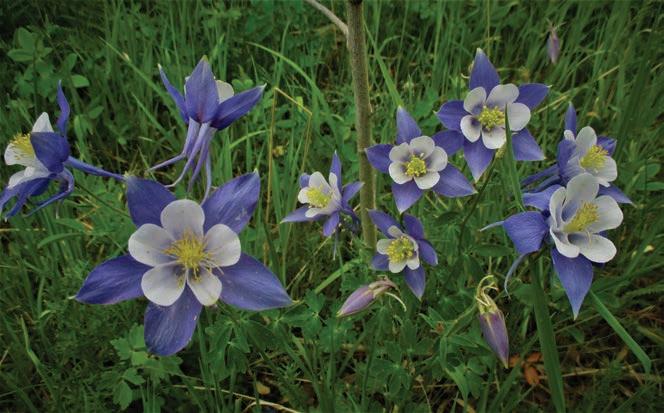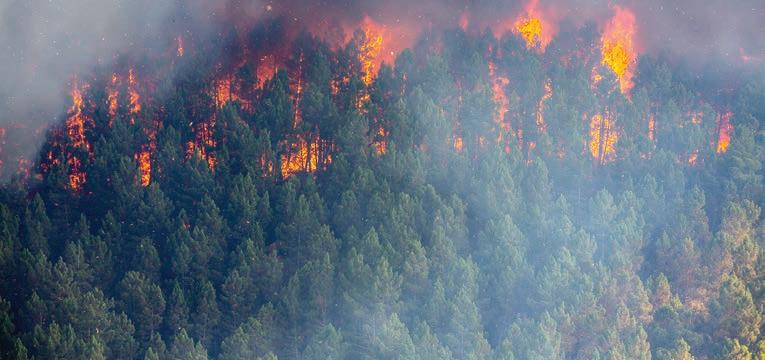
6 minute read
GARDENING AS IF NATURE MATTERS
Above: The Silvery Lupine attracts many varieties of bees and butterflies
Right: The lavender Columbine attracts hummingbirds and butterflies.

By Dennis Swiftdeer Paige
Coming from northeastern Illinois back in the fall of 2016 I was spoiled in terms of adequate water, a temperate climate, very workable soil, few pesty critters and a longer growing season to boot. Not so when I came to the montane plant zone of Colorado. We moved here a little over 7 years ago and what I have learned as a native landscaper, attempting to ecologically apply a healing approach to the land, is to stand back and watch what your land is telling you.
There are basic understandings that I wish to address to those just starting to garden for bringing nature back to your piece of the planet. First, native plants, also called indigenous plants, are plants that have evolved over thousands of years in a particular region. They have adapted to the geography, hydrology, and climate of the region. Native plants have evolved with the pollinators as well as other plants. As a result, a community of native plants provides habitat for a variety of native wildlife species such as songbirds and butterflies seeking host plants to lay their eggs while feeding off the nectar and leaves.
Non-native plants, also called non-indigenous plants, invasive plants, exotic species, or weeds, are plants that have been introduced into an environment in which they did not evolve. Such monoculturally aggressive plants like Canada thistle and Myrtle spurge can pose harm on the ecology of other native plants and wildlife.
So why should you use native plants? Here are my reasons:
1) Native plants do not require fertilizers.
2) They are hardy, drought resistant and require fewer pesticides than lawns.
3) They help reduce air pollution and sequester carbon, thus helping to contain the increase of global warming.
4) They provide shelter and food for wildlife.
5) They promote biodiversity and stewardship of our natural heritage.
6) They save money.
7) They entertain and inspire the deeper nurturing connections with nature rooted where you live.
8) They provide beautiful aesthetic impressions of nature.
Last year I applied with the National Wildlife Federation to receive the status stating our property is certified as a Wildlife Habitat. We have a seasonal creek, scattered aspens, Doug firs and Ponderosas, and 4 newly installed wren-chickadee bird houses on opposite corners of our land along with a bat house to go after the Western spruce budworm moths in the late spring.
So far on our half acre lot I have been able to identify 75 native plant species and still counting over the years. To help get you started you can check out these useful links:
•Native Plants: nwf.org/Garden-for-Wildlife/ About/Native-Plants
•Resources: homegrownnationalpark.org
•Certify: nwf.org/Garden-For-Wildlife/Certify
•Colorado Native Plant Society: conps.org
We continue to grow through hands-on understanding as we experience this little challenging earth with humility, patience, and knowledge.
Dennis Swiftdeer Paige is an environmental educator and native landscaper in Conifer. His is the author of Community Eco-gardens: Landscaping with Native Plants. Community Eco-Gardens – McFarland (onpressidium.com) He presents eco-garden talks based on his book through zoom regularly. Contact Dennis at littleearth21@hotmail.com.
Tupper Briggs and John Erlandson An Improving Market?
TB. John, with interest rates stabilizing and prices rising more slowly, are you seeing business pick up with the warming weather?
JE. We can feel the positive push up here in the foothills with more listings and more buyers. Of course, we have an advantage in working in the foothills since so many folks want to live in this paradise. We find today’s buyers & sellers realize there’s more to real estate than all the alarmist headlines about a housing crash. Bottom line… folks still want to buy, and folks still want to sell.
TB. I agree. While the inflation fight has taken its toll on the number of sales, home values continue to rise, proving that buyers who are willing & able to buy are making a sound investment.
JE. We recently closed on a home that was listed by a “down the hill” agent who over-reacted to the headlines about home values softening. He underpriced the property and our buyers jumped on it because they realized the pricing flaw.Our buyers wake up with a smile every day.Tup, home values continue to rise. What are the stats on that, and what do you predict going forward?
TB. The number of home sales dropped off by nearly 30% but the average home’s selling price rose by10% at the end of ’22. The number of home sales is still down from last year’s levels but the average selling price continues to rise. There’s structural under-supply to meet high demand for housing across the entire country that will buoy real estate for years to come.
JE. Buyers come in all shapes and sizes, but they all believe in the American dream of homeownership. We find buyers in general have moved from a cautious reticence to a more settled optimism. What are you seeing, and what do you think the perfect buyer looks like? Perfect seller?
TB. I think the perfect buyer is someone who is mentally & financially comfortable buying with today’s prices & interest rates and whose outlook is positive. The perfect seller is someone who has a good reason to sell, enjoys robust equity from the last couple of years, and is willing to price & stage their home competitively.
JE. Yeah, our buyers are not the kind that sit and sour over negative press. They dream and they do, despite what the negative gloomers and doomers say. Interest rates have settled down since the Fed started their battle with inflation last year but some buyers are still on the sidelines. Do you think we’ve seen the worst of the effects of any economic downturn?
TB. Yeah, I’m looking forward to more buyer activity as the year unfolds. I expect home values to hold their own through ’23 and show positive growth in ’24. This is a great opportunity for buyers who are willing and can afford to buy.
JE. Do you know how to tell if a banjo player is worried?

TB. No, how?
JE. He frets a lot.
TB. Groan…
Homeowner’s insurance in the Foothills has become costly and uncertain in the a ermath of the Marshall Fire in Boulder County. Many homeowners impacted by that re discovered that they were underinsured, and that the cost to rebuild in many cases was much higher than the dwelling coverage in their homeowner policies.
The cost to rebuild in the Foothills is typically higher than the cost to rebuild “down the hill” in the greater Denver area. Homes in the Foothills are located in a wildland-urban Interface zone which is an area where homes and businesses are at higher risk because of the proximity to forest land. The potential for wildfires is much greater here than in an urban area.
It is a good idea to review your home policy coverage amounts with your insurance professional annually, and ideally at the policy renewal date. Here are some things to look at when reviewing your home insurance:
Dwelling coverage—this is the base amount of coverage in the policy to replace your home in the event of a total loss. Most policies have an extended replacement cost provision in the event that the base dwelling coverage is not enough to rebuild the home with the same fit, finish, and quality as before the loss. This additional dwelling coverage amount is typically 20-50% of the base dwelling coverage amount. Your home should be insured for a minimum of $300 per finished square foot as a baseline amount for what it would cost to rebuild that home in the Foothills area.
Loss of Use coverage—this is coverage for any expense you incur when you are displaced from your home because of a covered loss. The reimbursement for those expenses typically defaults to twelve months from the date of loss. This is not a long enough time period for loss of use coverage. Victims of the Marshall Fire, which happened over twelve months ago, have still not had enough time to rebuild their homes. This coverage should be extended to 24 months, as it will take 18 to 24 months to rebuild your home in the event of a total loss.

Building Ordinance or Law coverage—this is additional coverage to help defray additional building costs that result from county building code and ordinance changes. Boulder County changed building codes to include requirements to use fire resistant materials, ecologically friendly materials, and other code changes that increased construction costs dramatically, driving up the cost to rebuild for Marshall Fire victims.
This coverage should be a minimum of 10-25% of the dwelling coverage to compensate for increased building costs of new codes.
Many insurance companies are not accepting new home policies in our area and many companies are non-renewing existing customers because of the perceived wildfire risk in the Foothills. Home policy premiums are rising because of the wildfire danger. That’s why it is wise to review your home policy with your insurance professional. It is better to understand and adjust your coverage now before a catastrophic loss event happens.
Bruce Anderson

Farmers Insurance
4860 Highway 73, Unit A Evergreen, CO 80439-7381
303-674-2724 (Office)
303-718-9966 (Mobile) banderson2@farmersagent.com www.farmersagent.com/banderson2
39682_1








